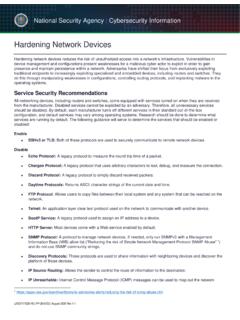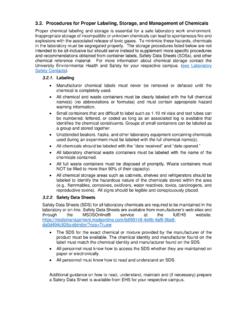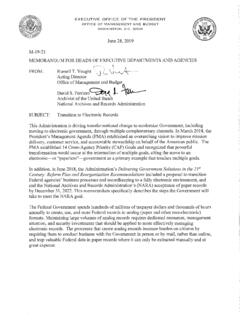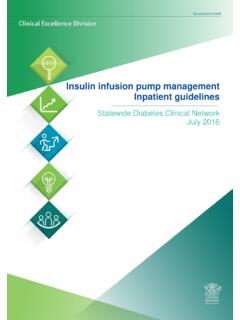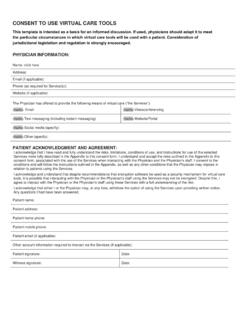Transcription of Materials Handling and Storage - Occupational Safety and ...
1 OSHA 22362002 (Revised) Materials Handlingand should your employees know before moving, Handling , and storing Materials ?.. 1 What are the potential hazards for workers?.. 2 What precautions should workers take whenmoving Materials manually?.. 2 What precautions should workers take whenmoving Materials mechanically?.. 3 What precautions must workers take to avoidstorage hazards? .. 4 What safeguards must workers follow whenstacking Materials ?.. 5 Important Safety Safety measures should employers takeregarding conveyors?.. 7 What Safety measures should employers takeregarding cranes?
2 8 What must employers do to ensure the safe useof slings?.. 10 What must employers do to protect workers whooperate powered industrial trucks?.. 10 What are the Safety requirements for design?.. 11 What are the Safety requirements for modification?.. 11 What are the Safety requirements for modification?.. 11 What Safety precautions should employers andworkers observe when operating or maintainingpowered industrial trucks?.. 13 Are there any training requirements for operatorsof powered industrial trucks?.. 14ivBasic Safety and Health is ergonomics?
3 16 What about fire Safety ?.. 16 What about aisles and passageways?.. 17 Training and the prevention of some injuries receive specialemphasis? .. 18 How can employers make their training programsmore effective?.. 19 OSHA are Safety and health system managementguidelines? .. 20 What are state programs?.. 21 How do I obtain consultation services?.. 21 What are Voluntary Protection Programs (VPPs)?.. 22 What is the Strategic Partnership Program?.. 23 Does OSHA offer training and education?.. 23 Does OSHA provide any information electronically?
4 24 How do I learn more about related OSHA publications?.. 25 How do I contact OSHA about emergencies, complaints,or further assistance?.. Office Regional 28 OSHA Area 29 State and Territories with Approved 32 OSHA Consultation 351 IntroductionHandling and storing Materials involve diverse operationssuch as hoisting tons of steel with a crane; driving a truckloaded with concrete blocks; carrying bags or materialsmanually; and stacking palletized bricks or other materialssuch as drums, barrels, kegs, and efficient Handling and storing of Materials are vital toindustry.
5 In addition to raw Materials , these operationsprovide a continuous flow of parts and assemblies throughthe workplace and ensure that Materials are available whenneeded. Unfortunately, the improper Handling and storing ofmaterials often result in costly should your employees know beforemoving, Handling , and storing Materials ?In addition to training and education, applying generalsafety principles such as proper work practices, equipment,and controls can help reduce workplace accidents involvingthe moving, Handling , and storing of Materials .
6 Whethermoving Materials manually or mechanically, your employeesshould know and understand the potential hazards associatedwith the task at hand and how to control their workplaces tominimize the numerous injuries can result from improperlyhandling and storing Materials , workers should also be awareof accidents that may result from the unsafe or improperhandling of equipment as well as from improper workpractices. In addition, workers should be able to recognizethe methods for eliminating or at least minimizing theoccurrence of such accidents.
7 Employers and employeesshould examine their workplaces to detect any unsafe orunhealthful conditions, practices, or equipment and takecorrective are the potential hazards for workers?Workers frequently cite the weight and bulkiness ofobjects that they lift as major contributing factors to theirinjuries. In 1999, for example, more than 420,000 workplaceaccidents resulted in back injuries. Bending, followed bytwisting and turning, were the more commonly citedmovements that caused back hazards include falling objects, improperly stackedmaterials, and various types of equipment.
8 You should makeyour employees aware of potential injuries that can occurwhen manually moving Materials , including the following: Strains and sprains from lifting loads improperly or fromcarrying loads that are either too large or too heavy, Fractures and bruises caused by being struck by materialsor by being caught in pinch points, and Cuts and bruises caused by falling Materials that have beenimproperly stored or by incorrectly cutting ties or othersecuring precautions should workers takewhen moving Materials manually?When moving Materials manually, workers should attachhandles or holders to loads.
9 In addition, workers shouldalways wear appropriate personal protective equipment anduse proper lifting techniques. To prevent injury from oversizeloads, workers should seek help in the following: When a load is so bulky that employees cannot properlygrasp or lift it, When employees cannot see around or over a load, or When employees cannot safely handle a the following personal protective equipmentprevents needless injuries when manually moving Materials : Hand and forearm protection, such as gloves, for loadswith sharp or rough edges.
10 Eye protection. Steel-toed Safety shoes or boots. Metal, fiber, or plastic metatarsal guards to protect theinstep area from impact or OSHA s booklet, Personal Protective Equipment(OSHA 3077), for additional should use blocking Materials to manage loadssafely. Workers should also be cautious when placing blocksunder a raised load to ensure that the load is not releasedbefore removing their hands from under the load. Blockingmaterials and timbers should be large and strong enough tosupport the load safely. In addition to Materials with cracks,workers should not use Materials with rounded corners,splintered pieces, or dry rot for precautions should workers takewhen moving Materials mechanically?










